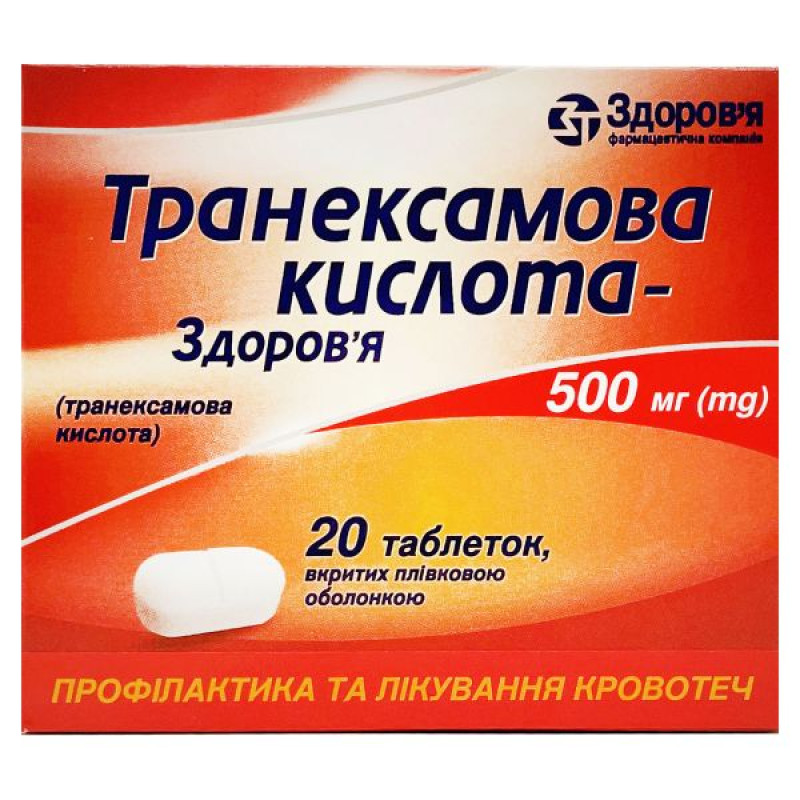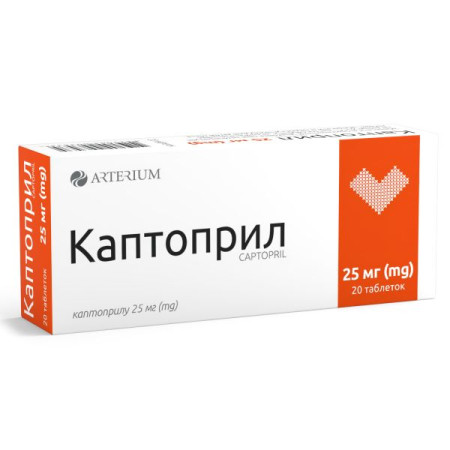Tranexamic acid-Health film-coated tablets 500 mg No. 20

Instructions Tranexamic acid-Health film-coated tablets 500 mg No. 20
Composition
active ingredient: tranexamic acid;
1 tablet contains tranexamic acid 500 mg;
excipients: microcrystalline cellulose, povidone, colloidal anhydrous silica, talc, magnesium stearate, crospovidone, dry mixture "Opadry white" containing titanium dioxide (E 171), hypromellose, triacetin.
Dosage form
Film-coated tablets.
Main physicochemical properties: film-coated tablets, white or almost white, oval in shape, with a score on one side.
Pharmacotherapeutic group
Antihemorrhagic agents, antifibrinolytic amino acids. Fibrinolysis inhibitors. ATX code B02A A02.
Pharmacological properties
Pharmacodynamics.
Antifibrinolytic agent. Tranexamic acid specifically inhibits the activation of profibrinolysin (plasminogen) and its conversion to fibrinolysin (plasmin). It has a local and systemic hemostatic effect in bleeding associated with increased fibrinolysis (platelet pathology, menorrhagia). Tranexamic acid also has antiallergic and anti-inflammatory effects by inhibiting the formation of kinins and other active peptides involved in allergic and inflammatory reactions.
Pharmacokinetics.
Absorption with oral administration of doses in the range of 0.5–2 g is 30–50%. TCmax with oral administration of 0.5 g, 1 g and 2 g is 3 hours, Cmax is 5, 8 and 15 μg/ml, respectively. Binding to blood plasma proteins (profibrinolysin) is not less than 3%.
It is distributed in tissues relatively evenly (except in cerebrospinal fluid, where the concentration is 1/10 of the plasma concentration); penetrates through the placental barrier, into breast milk (about 1% of the concentration in maternal plasma). It is found in seminal fluid, where it reduces fibrinolytic activity, but does not affect sperm migration. The initial volume of distribution is 9–12 l. Antifibrinolytic concentration in various tissues persists for 17 hours, in plasma – up to 7–8 hours.
A small part is metabolized. The AUC curve has a triphasic shape with T1/2 in the final phase of 3 hours. Total renal clearance is equal to plasma (7 l/h). Excreted by the kidneys (the main route is glomerular filtration), about 95% - in unchanged form during the first 12 hours.
Two metabolites of tranexamic acid have been identified: the N-acetylated and deaminated derivatives. In cases of impaired renal function, there is a risk of accumulation of tranexamic acid.
Indication
Bleeding or risk of bleeding with increased fibrinolysis, both generalized (bleeding during prostate surgery and in the postoperative period, hemorrhagic complications of fibrinolytic therapy) and local (uterine, gastrointestinal, nasal bleeding, post-traumatic hyphema, bleeding after prostatectomy or bladder surgery, tonsillectomy, conization of the cervix, tooth extraction in patients with hemophilia).
Hereditary angioedema.
Contraindication
Hypersensitivity to tranexamic acid or to other components of the drug, severe renal failure (due to the risk of cumulation), macroscopic hematuria, acute thromboembolic diseases, acute venous or arterial thrombosis, thrombophlebitis, history of arterial or venous thrombosis, high risk of thrombosis, myocardial infarction, subarachnoid hemorrhage, history of seizures; fibrinolytic states due to consumption coagulopathy, except for excessive activation of the fibrinolytic system in acute severe bleeding; impaired color perception.
Interaction with other medicinal products and other types of interactions
Tranexamic acid is incompatible with urokinase, norepinephrine bitartrate, desoxyepinephrine hydrochloride, metarmin bitartrate, dipyridamole, diazepam. Highly active prothrombin complexes and antifibrinolytic agents, antiinhibitory coagulation complexes should not be used simultaneously with tranexamic acid. The combination of chlorpromazine and tranexamic acid should be avoided in patients with subarachnoid hemorrhage; this may lead to cerebral vasospasm and cerebral ischemia and, possibly, to a decrease in cerebral blood flow; the symptomatic properties of both drugs may contribute to the development of vasospasm and cerebral ischemia in these patients. Tranexamic acid should be used with caution in patients taking oral contraceptives, since the risk of thrombosis is increased.
Application features
In case of renal failure (depending on the degree of increase in serum creatinine), it is necessary to reduce the dose and number of injections.
In the event of hematuria of renal origin (especially in hemophilia), the risk of mechanical anuria increases due to the formation of a blood clot in the urinary tract.
Occlusion of the central retinal artery and central retinal vein has been reported. Patients taking the drug for more than a few days are advised to undergo an ophthalmological examination, including testing of visual acuity, color perception, fundus, visual fields, and assessment of liver function.
This medicine should not be used until the cause of the menstrual irregularity is determined. If menstrual bleeding is not reduced with tranexamic acid, alternative treatment should be considered.
Tranexamic acid should be used with caution in patients taking oral contraceptives due to the increased risk of thrombosis.
Cases of venous and arterial thrombosis or thromboembolism have been reported in patients taking tranexamic acid. Patients with a previous thromboembolic event or a family history of thromboembolic disease (thrombophilia) should use the drug only if clearly indicated and under strict medical supervision.
The use of tranexamic acid is not recommended in cases of increased fibrinolysis due to disseminated intravascular coagulation.
Patients with disseminated intravascular coagulation who require treatment with tranexamic acid should be supervised by a physician experienced in the treatment of such conditions.
There is no clinical experience with the use of tranexamic acid in children under 15 years of age with menorrhagia, therefore the drug should not be used in this category of patients.
Tranexamic acid should not be taken concomitantly with Factor IX complex or anti-inhibitor coagulation complexes, as the risk of thrombosis may be increased.
Tranexamic acid was detected in semen at fibrinolytic concentrations, but it did not affect sperm motility. Clinical studies have shown no effect on fertility.
Convulsions have been reported with the use of tranexamic acid. Most of these cases have been reported after intravenous administration of high doses of tranexamic acid during coronary artery bypass grafting (CABG). When using the recommended low doses of tranexamic acid, the incidence of postoperative seizures is similar to that in patients not receiving tranexamic acid.
Use during pregnancy or breastfeeding
Tranexamic acid crosses the placenta and enters breast milk. Studies on the safety of the drug during pregnancy have not been conducted, so the drug can be prescribed to pregnant women only if the expected benefit to the woman outweighs the potential risk to the fetus.
If necessary, the use of the drug should be considered for discontinuation of breastfeeding.
Ability to influence reaction speed when driving vehicles or other mechanisms
While using the drug, you should refrain from driving or working with complex mechanisms.
Method of administration and doses
The drug should be administered orally. Taking the drug does not depend on food intake.
Adult patients with normal renal function.
The following dosage recommendations should be followed for adult patients with normal renal function and creatinine clearance above 50 ml/min.
| Indication | Single dose | Number of receptions per day | Duration of treatment | Notes |
| Local fibrinolysis | 1–1.5 g | 2–3 times | 3–15 days | |
| Prostatectomy | 1 g | 3–4 times | Until the disappearance of macroscopic hematuria | For the prevention and treatment of hemorrhages in patients with an increased risk of their occurrence, use before or after surgery in the form of injections, and then prescribe in the form of tablets. |
| Menorrhagia | 1 g | 3 times | Up to 4 days | For prolonged menstrual bleeding, increase the dose, but not above the maximum dose (4 g per day). It is not necessary to start treatment with the drug before the onset of menstrual bleeding. |
| Nosebleeds | 1 g | 3 times | 7 days | Use for periodic nosebleeds |
| Conization of the cervix | 1.5 g | 3 times | up to 12 days | |
| Post-traumatic hyphema | 1 g | 3 times | 3–15 days | |
| Hereditary angioedema | 1–1.5 g | 2–3 times | Depending on the course of the disease | |
| Tooth extraction in patients with hemophilia | 25 mg/kg | Every 8 hours | 3–10 days | Apply 1 day before surgery and continue for 2–8 days after surgery |
Elderly patients.
In the absence of renal excretory function disorders, dose adjustment is not required.
Children.
For children aged 12 years and older, the dose is 20–25 mg/kg. The duration of treatment is usually 2–8 days.
Patients with renal failure.
The dose should be adjusted according to the level of blood plasma creatinine.
| Blood plasma creatinine | Dosage |
| 120–249 μmol/L | 15 mg/kg 2 times a day |
| 250–500 μmol/L | 15 mg/kg once daily |
Children: Do not use in children under 12 years of age.
There is no clinical experience with the use of tranexamic acid in children under 15 years of age with menorrhagia, therefore this drug should not be used in this category of patients.
Overdose
Symptoms: nausea, vomiting, abdominal pain, orthostatic hypotension, hypotension, dizziness, headache, seizures or increased manifestations of other adverse reactions, including the risk of thrombosis.
Treatment: induce vomiting, gastric lavage, take activated charcoal. It is necessary to drink plenty of fluids to promote renal excretion. Apply symptomatic treatment and, if necessary, anticoagulant therapy.
Adverse reactions
Immune system disorders: hypersensitivity reactions, including anaphylaxis.
On the part of the digestive system: nausea, vomiting, heartburn, diarrhea, abdominal pain, decreased appetite.
Skin and subcutaneous tissue disorders: rash, itching, allergic skin reactions.
From the nervous system: drowsiness, dizziness, convulsions.
On the part of the organs of vision: visual impairment, color vision impairment, retinal artery occlusion, congestive retinopathy.
Vascular: thromboembolic complications, arterial or venous thrombosis of any location, arterial hypotension.
Renal: acute renal cortical necrosis.
Expiration date
2 years.
Storage conditions
Store in the original packaging at a temperature not exceeding 25 ºС.
Keep out of reach of children.
Packaging
Tablets No. 20 (10×2) in blisters in a box.
Vacation category
According to the recipe.
Producer
Limited Liability Company "Pharmaceutical Company "Zdorovya".
Location of the manufacturer and address of its place of business.
Ukraine, 61013, Kharkiv region, Kharkiv city, Shevchenko street, building 22.
There are no reviews for this product.
There are no reviews for this product, be the first to leave your review.
No questions about this product, be the first and ask your question.


